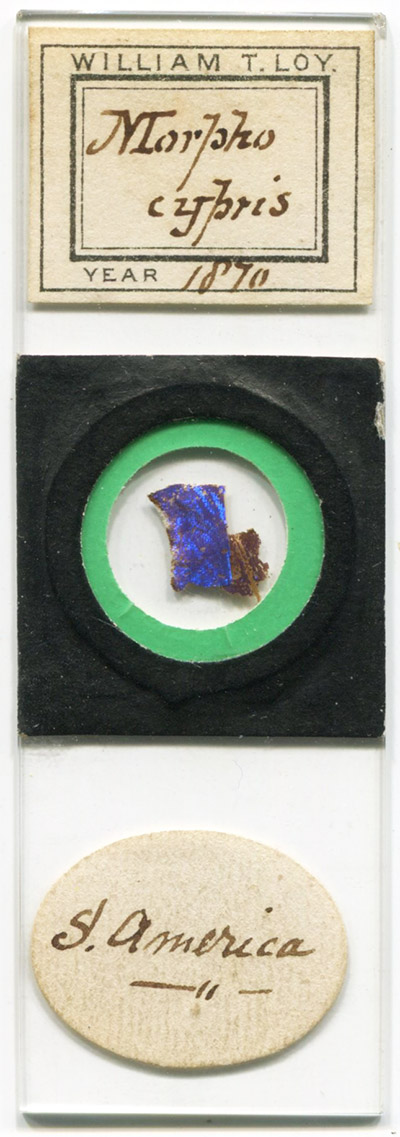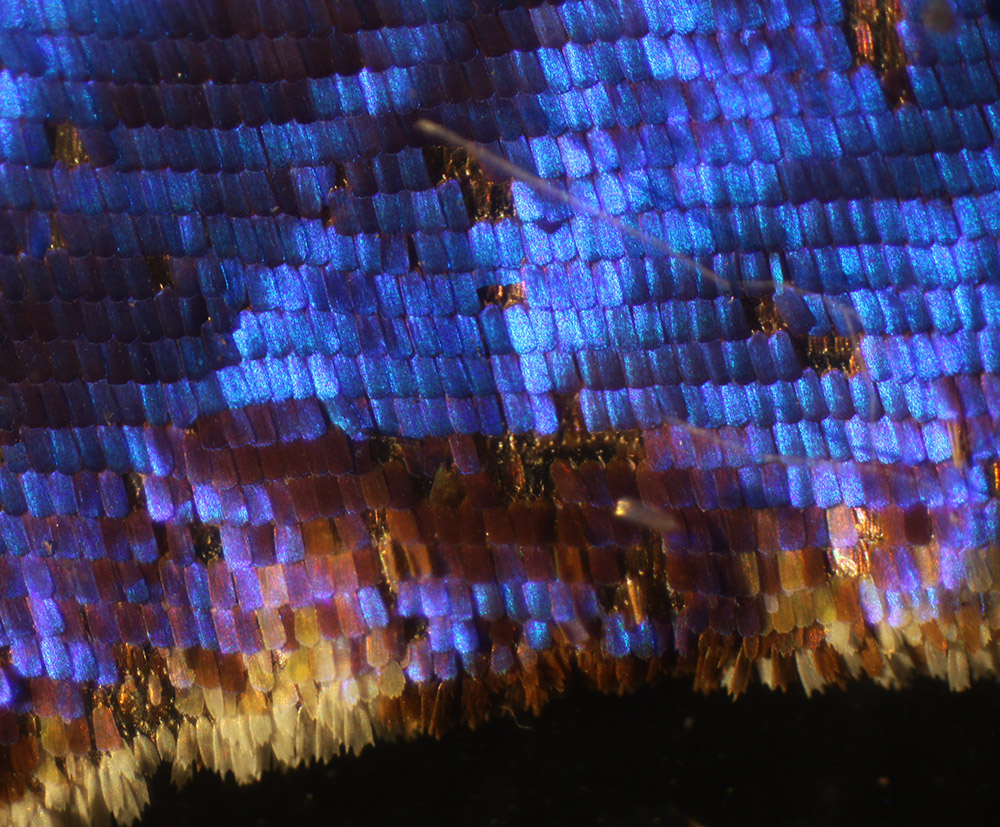
Figure 1. Section of wing from a Morpho cypris butterfly, mounted by W.T. Loy in 1870.
William Thomas Loy, ca. 1828 - 1886
by Brian Stevenson
last updated January, 2021
William T. Loy was a London-based cutler and cotton broker, and a very enthusiastic microscopist. He was a Fellow and Councilmember of the Royal Microscopical Society, and a member of the Quekett Microscopical Club, the Croydon Microscopical Club, and the Society of the Arts. Loy’s microscopical preparations, in particular his dissections of insect, were highly regarded by his colleagues. Loy’s microscope slides are occasionally seen nowadays, such as the "neatly mounted" sections of Morpho cypris butterfly wing that he advertised for exchange in 1870 (Figures 1-3).

Figure 1.
Section of wing from a Morpho cypris butterfly, mounted by W.T. Loy in 1870.

Figure 2.
Exchange offers from William T. Loy that were published in "Hardwicke's Science-Gossip". The microscope slide shown in Figure 1 was offered by Loy in 1870.
William Thomas Loy was born ca. 1828 in St. Margaret's parish, Westminster. His father, also named William, was a manufacturer of cutlery, who had moved to the London area from Sheffield shortly before young William’s birth.
The 1851 census listed William T. Loy as a "cutler", living at 24 King Street, Westminster, with his father, mother, and a sister. The elder Loy was also listed as being a "cutler", with a note that he employed "2 men". The previous year, young William had been awarded a patent for the "Tudor razor guard".
The father and son exhibited separately at the 1851 Great Exhibition: "Loy, W.T. Jun" was listed as a designer and manufacturer at 60 St. Martin’s Lane and exhibiting "razors and other articles of cutlery", while his father, "Loy, W" of 24 King Street, Whitehall, manufacturer, displayed "club skates, ladies’ skates, &c." (i.e. ice skates).
During the 1860s, William T. Loy’s career took a different direction, becoming involved with cotton fabric manufacturing and brokerage. The 1861 national census recorded him as a "merchant", living in Croydon, Surrey, with an unmarried sister and a domestic housekeeper. In 1861, Loy was awarded a patent for "improved machinery or apparatus for carding cotton, and other fibrous substances of a similar character".
On April 27, 1866, Low was elected into membership of the Quekett Microscopical Club. He also joined the Society of Arts that same year. On December 11, 1867, he became a Fellow of the Royal Microscopical Society. By 1874, Loy had become a member of the RMS Council, and served in that office for several more years.
I located two microscope-related exchange offers from Loy: an 1867 request to receive microscope slides of insects or injected animal/human tissues, for which he would proved "Chinese beetles" (apparently, unmounted); and an 1870 offer to provide "portions of wing (neatly mounted)" of Morpho cypris butterflies in exchange for injected mounts (Figure 2). Since Loy produced the latter slide in quantity, it is the most likely of his works to be encountered nowadays.
Loy acquired a reputation as an excellent insect dissector and mounter. In 1878, T. Charters White wrote in The Journal of the Quekett Microscopical Club, "All who have seen the dissections made by our friend and fellow member, Mr. W.T. Loy, must have admired the skill and neatness with which they were done, and could only regret that he had not in many more instances carried them on to the isolation of the separate organs of each insect, for no member seems to possess greater operative delicacy than he".
Similarly, the minutes of the December 9, 1874 meeting of the Royal Microscopical Society highlighted that "Mr. Loy's modestly-mentioned 'Dissections of lepidopterous larvae', comprised a large collection of objects, prepared and mounted with extraordinary skill". In addition to those dissected caterpillars, Loy also showed "salivary glands of Java cockroach, Periplaneta orientalis" during that evening. A few years later, on May 21, 1879, minutes of the RMS reported that Loy exhibited a "series of dissections illustrating the anatomy of Meloë cicatricosus and larva of Bombyx mori with dorsal vessels injected" (blister beetle and silkworm, respectively).
As evidenced by the above-noted Java cockroaches and Chinese beetles, W.T. Loy had access to quantities of foreign insects. Moreover, the Java cockroaches were likely alive when he obtained them, in order for him to have performed detailed dissections. It is possible that foreign customers of his cotton brokerage business helped supply Loy with these exotic specimens. Colleagues benefitted from Loy’s connections: in 1872, S.J. McIntire wrote on springtails, which included descriptions of, "importations from West Africa and Bombay respectively - have been given me by W.T. Loy, Esq., in a living state. The former was much whiter than our English species, though its scales were very similar; and the latter was a speckled insect, its colours being black, brown, and drab, without any iridescence. The scales are very beautiful objects under high power, and different from L. saccharina".
White’s 1878 paper on insect dissection provided a description of W.T. Loy's cheap and simple dissection apparatus: "By his kindness I had an opportunity of inspecting a very ingenious method of adapting his magnifying power to his work, which I should like to describe to you, although I have not his permission for so doing: it struck me by its simplicity, as well by its efficacy, and therefore I trust I may be allowed to mention it without incurring the character of revealing any private affair. It consists of a heavy metal foot, into which an upright iron rod is fixed - round this rod is coiled one end of a stout wire, the other end of the wire being bent into a ring to hold a watchmaker's eye-glass; this arrangement, by pressing the head down, focusses the lens upon the work while both hands are at liberty, and when I tell you that all these beautiful dissections of his were accomplished by such a contrivance, it will be sufficiently recommended to your use, even if we leave out of consideration its comparative cheapness, compared with other optical arrangements". In other words, Loy accomplished his remarkable insect dissections using only a plain biconvex lens that was supported by a ring of common wire, with an end of the supporting wire wrapped around an upright metal rod, and focusing achieved by sliding the wrapped wire up-and-down the vertical rod.
William Loy did not marry. As noted above, the 1861 census found him with his sister and a servant at Breston Lodge, Croydon, Surrey. In 1866, when he joined the Society of Arts, Loy lived on Dingwall Road, Croydon. His 1867 offer to exchange Chinese beetles for microscope slides (Figure 2) gave his address as 10 Rood Lane, Eastcheap, London (although this could have been his business address). By 1870, he was at 11 Garrick Chambers, Covent Garden, London, and kept that address until at least 1884. The 1873 London Electoral Register described his Garrick Chambers home as an unfurnished residential chambers on the second floor, with an annual rent of £50. Loy appears to have taken a second home by 1881, being recorded in that year’s census as a "visitor" (i.e. boarder) in Lee Green, London, while also retaining the Garrick Chambers apartment, according to voting records. The 1863 member list of the Quekett Microscopical Club gave Low’s address as Five Oaks, Billingshurst, Sussex.
William Thomas Loy died at his home in Billingshurst on July 7, 1886, at the age of 58.

Figure 3.
Figure 3. Portion of wing from a Morpho cypris butterfly, dry-mounted in 1870 by William T. Low (see Figures 1 and 2). Photographed with a 3.5x objective lens and C-mounted digital SLR camera.
Resources
England census and other records, accessed through ancestry.com
English Patents of Inventions, Specifications: 1862, 1253-1321 (1862) "Letters Patent to William Thomas Loy, of Rood Lane, in the City of London, for the Invention of Improved Machinery or Apparatus for Carding Cotton, and Other Fibrous Substances of a Similar Character"
Hardwicke’s Science-Gossip (1867) Exchange offer from William T. Loy, Vol. 3, page 72
Hardwicke’s Science-Gossip (1870) Exchange offer from William T. Loy, Vol. 6, page 168
The Journal of the Quekett Microscopical Club (1878) Members, Vol. 5
The Journal of the Quekett Microscopical Club (1880) Members
The Journal of the Quekett Microscopical Club (1883) Members
The Journal of the Royal Microscopical Society (1879) List of Officers of the Royal Microscopical Society, Vol. 2
The Journal of the Royal Microscopical Society (1879) Minutes of the meeting of May 21, Vol. 2, page 652
Journal of the Society of Arts (1866) "The following candidates were balloted for, and duly elected members of the Society … Loy, William T., Dingwall-road, Croydon, S.", Vol. 14, page 354
London Electoral Register (1873) accessed through ancestry.com
London Electoral Register (1880) accessed through ancestry.com
London Electoral Register (1884) accessed through ancestry.com
The London Journal of Arts and Sciences (1850) Patent: "July.13. William Thomas Loy, of 24, King street, Westminster, for “the Tudor razor guard", page 62
McIntire, S.J. (1872) The Thysanuradae, Hardwicke’s Science-Gossip, pages 272-227
The Monthly Microscopical Journal (1871) Fellows, Vol. 6
The Monthly Microscopical Journal (1871) Croydon Microscopical Club, Vol. 6, page 56
The Monthly Microscopical Journal (1874) List of Officers of the Royal Microscopical Society, page 136
The Monthly Microscopical Journal (1874) Minutes of the meeting of December 9, pages 37-38
Official Catalogue of the Great Exhibition of the Works of Industry of All Nations (1851) "Cutlery, Edge and Hand Tools … 14 Loy, W. 24 King St. Whitehall, Manu. - Club skates, ladies’ skates, &c. … 15 Loy, W.T. Jun. 60 St. Martin’s lane, Des. and Man. - Razors and other articles of cutlery", page 108
Probate of the will of William T. Loy (1886) "The Will of William Thomas Loy late of Five Oaks Billingshurst in the County of Sussex who died 7 July 1886 at Five Oaks was proved at the Principal Registry by Ann Day of Five Oaks Widow the Sister the sole Executrix. Personal Estate £96", accessed through ancestry.com
The Transactions of the Microscopical Society of London (1867) Minutes of the meeting of November 13, Vol. 16, page 58
White, T. Charters (1878) A few remarks on insect dissection, The Journal of the Quekett Microscopical Club, Vol. 5, pages 33-37